Cataract Surgery
Laser Assisted Cataract Surgery
Just as you have options when it comes to choosing the lens that you receive during cataract surgery, you also have the option of choosing the technology that’s used to perform the procedure. That means you have the choice between surgery performed by hand or with the assistance of laser technology.
Either type of procedure can be effective when performed by a skilled surgeon, but laser-assisted cataract surgery procedures are generally more predictable and precise. Laser-assisted cataract surgery technology can automate certain steps during the procedure with laser precision.

The LenSx® Laser system maps your eye, assisting in a cataract surgery that’s unique to you.
Customized Precision with the LenSx® Laser
If you opt for laser cataract surgery, your surgeon may operate using the LenSx® Laser, which offers a level of accuracy exceeding that of manual surgery methods. The LenSx® Laser first images your eye to plan a procedure that’s unique to you. A bladeless, computer-controlled laser then helps surgeons perform your surgery with exacting, individualized precision not attainable with traditional surgical methods.
What is a Cataract?

A cataract is a clouding of the lens inside the eye that obstructs normal vision. Typically, your eye’s lenses should be clear, allowing you to see people and objects in crisp focus. Cataracts, though, create a fog-like effect over all or part of the lenses so that things appear blurry and out of focus.
When your eyes’ lenses are working the way they should, light passes through the cornea (this is the clear dome that sits over the front of your eye) and the pupil (the black hole at the center of the colored iris of your eye) into the lens. The lens is located just behind the iris and the pupil. It focuses light to produce sharp pictures of what you’re seeing on the retina (the membrane on the back wall of your eye). As a cataract develops, the lens becomes clouded and delivers fuzzy images to your retina, causing your vision to be blurry.
How Do Cataracts Develop?
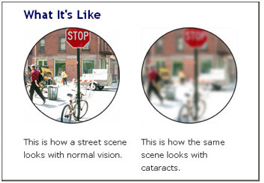
Cataracts develop slowly over time in most cases (the exceptions being trauma and injury). Although they can materialize separately, cataracts typically develop symmetrically in both eyes. They can affect all or only part of the eye’s lens. You might not notice the clouding at first, but as it progresses, your vision can be severely interrupted. The process begins with needing more reading light or eyeglasses, but you may notice that as the cataracts worsen, you begin thinking about cataract surgery to correct the problem.
Who is at Risk for Cataracts?
The most common determinant of cataract surgery patients is age. For older adults, cataracts are surprisingly common. Some 66 percent of all people over the age of 60 male and female alike, commonly get cataracts. Many people do not realize cataracts are the leading cause of blindness. Cataracts can develop at any age, however, due to a variety of diseases or congenital conditions. Besides aging, some causes of cataracts include:
- Long-term exposure to ultraviolet light
- Long-term or short-term exposure to radiation
- Peripheral effects of certain diseases, such as diabetes and hypertension
Get back your youthful vision now!
Choices in Intraocular Lens Implants for Cataract Patients
As you get older, the natural lens inside your eye becomes firm and opaque, reducing visual clarity, decreasing contrast details, and causing glare. When the lens begins to reduce vision, it is known as a cataractous lens, or a "cataract," for short.
During cataract surgery, the lens is dissolved using ultrasound and vacuumed out of the eye. In its place, Dr. Dean places an intraocular lens implant.
When a cataract is removed, it is replaced with an intraocular lens. There are a variety of IOL's that can be used in cataract surgery. The FDA approval process for IOL's used in the United States have undergone rigorous testing for safety and effectiveness.
Cataract surgery using a no-stitch technique represents a wonderful opportunity for you to both improve vision AND become less dependent upon glasses.
Dr. Dean performs over 600 cataract surgeries per year, and our staff members are experts in the latest cataract surgery techniques and intraocular lens technology.
ReStor Multifocal Intraocular Lens
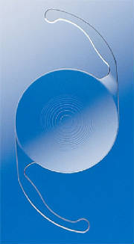 The prefix, "multi" means many, and a multifocal lens works at many different distances. Dr. Dean utilizes the Alcon ReSTOR Multifocal IOL. This lens has a series of rings that create different points of focus in the back of the eye.
The prefix, "multi" means many, and a multifocal lens works at many different distances. Dr. Dean utilizes the Alcon ReSTOR Multifocal IOL. This lens has a series of rings that create different points of focus in the back of the eye.
Patients who have ReSTOR lenses implanted are also less dependent upon glasses than patients with monofocal lenses. The ReSTOR lens works best for distance and near vision. Some patients who have ReSTOR lenses implanted often require an eyeglass for intermediate vision, such as seeing prices on a store shelf. Additionally because of the ring design, patients sometimes complain about reduced contrast on bright days, when their pupils are small.
Multifocal IOLs have a slighter greater tendency to cause night vision complaints than other IOLs, so those who drive a great deal at night may wish to consider a different IOL.
Medicare and supplemental insurers and other insurance companies pay for a portion of the cataract surgery. However, they do not pay for the additional costs associated with implanting or ReSTOR lens. Flexible payment plans are available.
AcrySof® IQ Toric
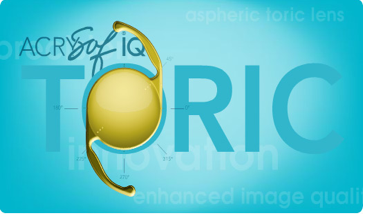 The latest in a long line of IOL innovations from Alcon, the new AcrySof® IQ Toric lens takes the most trusted platform for precise astigmatism correction and adds the enhanced image quality of an aspheric lens,taking the toric IOL to a whole new level.
The latest in a long line of IOL innovations from Alcon, the new AcrySof® IQ Toric lens takes the most trusted platform for precise astigmatism correction and adds the enhanced image quality of an aspheric lens,taking the toric IOL to a whole new level.
With the combined benefits of toricity and asphericity, the AcrySof® IQ Toric lens truly offers the best of both worlds:
Astigmatism Correction
- Unique toric design offers astigmatism patients the best opportunity for spectacle-independent distance vision
- AcrySof® single-piece platform ensures exceptional rotational stability, with less than 4º average rotation 6 months after implantation
- Range of cylinder powers includes patients with lower levels of astigmatism
Visual Performance
- Proven aspheric technology reduces spherical and higher order aberrations
- Aspheric optic offers increased contrast sensitivity and improved functional vision in challenging environments
- Proprietary blue light-filtering chromophore filters more than UV
Surgical Technique
Laser Assisted Cataract Surgery
Cataract surgery is an outpatient procedure performed at Day Kimball Hospital. This means you will only be there for a few hours and then you may go home. You will need to have a driver the day of surgery and the day after.
Dr. Dean performs his cataract surgery at Day Kimball Hospital's Ambulatory Care Unit. Click here for more information about Day Kimball Hospital.
Dr. Dean's current technique is a "clear cornea" technique and typically no stitches are needed. Topical anesthesia is normally used for this technique. The nurses will begin by placing eye drops in your eyes to dilate your pupil and numb and anesthetize the surface of your eye. Several sets of eye drops may administered for Cataract Surgery. The use of eye drop anesthesia is sufficient for most Cataract patients so that they feel just about nothing and experience little if any discomfort at all. In general it is not necessary for the Cataract Surgeon to use injections or needles to anesthetize your eye. On some occasions, a patient may need additional anesthesia such as a retrobulbar injection.
A small amount of IV sedative (a Valium type drug) is given for relaxation. An anesthesiologist will monitor the patient's vital signs. The patient is asked to fixate (look) at a light and generally feels no pain but may feel some pressure. If the patient experiences and undue discomfort, and additional anesthetic may be necessary. Patients frequently say the see "a light show" (no extra charge!) and are amazed when the procedure is done in 10-20 minutes.
Post-operative Care and Complication
 You will be taken down to the Ambulatory Care Unit after your operation is over. They will give you something to eat and instructions that Dr. Dean has prepared. A technician from Eye Northeast, PC will contact you later in the day to go over instructions and answer any questions or concerns you may have.
You will be taken down to the Ambulatory Care Unit after your operation is over. They will give you something to eat and instructions that Dr. Dean has prepared. A technician from Eye Northeast, PC will contact you later in the day to go over instructions and answer any questions or concerns you may have.
If you experience any severe pain, headache or discomfort, you need to call our office as soon as possible.
One-day Post Operative Exam
Dr. Dean will see you at this visit. You will be given three drops to use. These include and antibiotic, topical NSAID (non-steroidal anti-inflammatory) and a topical steroid. You will be given a printed instruction sheet. It is extremely important that you take your drops until told to stop.
Temporal Clear-Corneal Incision (No Stitch)
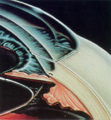 Yes, even the most modern techniques in cataract surgery require that an incision be made in the eye. No, cataract surgery cannot be performed with lasers (a common misconception; so called "secondary cataracts" can be treated with laser, but secondary cataracts only occur in eyes that have already had cataract surgery).
Yes, even the most modern techniques in cataract surgery require that an incision be made in the eye. No, cataract surgery cannot be performed with lasers (a common misconception; so called "secondary cataracts" can be treated with laser, but secondary cataracts only occur in eyes that have already had cataract surgery).
Over the past 20 years or so, incision size has come down from 16, to 12 to less than 3 millimeters in length. With the very small incisions used today, the preferred location of the incision has also changed. It is now possible to make micro-incisions in the temporal clear cornea, rather than the superior, sub-conjunctival, or "scleral-tunnel" approach. The principle advantages to temporal, clear-corneal incisions are: (1) they induce very little trauma, and therefore heal faster; (2) the cornea can be completely anesthetized with drops only, thereby facilitating topical anesthesia; and (3) they are easier to make, and safer to use for both the patient and the surgeon. We are not aware of any substantial disadvantage to the temporal, clear-corneal incision. Because this type of incision is so small, it does not require a stitch to close it.
Phacoemulsification ("fake-o-E-mull-sa-fa-kay-shun")
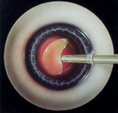 Phacoemulsification or Phaco is the modern method for removing cataracts utilizing high energy ultrasound. Using this technology, a cataract which measures 12 millimeters in diameter and 4 millimeters in thickness can be vacuumed through an incision which measures only 3 millimeter or less! Basically, phaco uses a hollow needle which, when activated by the surgeon, vibrates at 40,000 times per second thereby emulsifying the cataract. Emulsified cataract is aspirated through the hollow center in the phaco needle, and fluid is simultaneously infused into the eye in order to keep it "inflated" during surgery. Cataracts CANNOT be removed by laser.
Phacoemulsification or Phaco is the modern method for removing cataracts utilizing high energy ultrasound. Using this technology, a cataract which measures 12 millimeters in diameter and 4 millimeters in thickness can be vacuumed through an incision which measures only 3 millimeter or less! Basically, phaco uses a hollow needle which, when activated by the surgeon, vibrates at 40,000 times per second thereby emulsifying the cataract. Emulsified cataract is aspirated through the hollow center in the phaco needle, and fluid is simultaneously infused into the eye in order to keep it "inflated" during surgery. Cataracts CANNOT be removed by laser.
Foldable Lens Implant
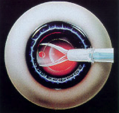 The final step in cataract surgery is lens implantation. Prior to the development of safe intra-ocular lens implants, anyone who had their cataracts removed was forced to wear incredibly thick and heavy glasses, or contact lenses to correct their vision to normal. A typical "three piece" lens implant looks like a miniature, round magnifying glass, about 6 millimeters in diameter, with two wiry attachments called haptics. The haptics extend out to a total diameter of about 13 millimeters, and when slightly compressed, they suspend the lens implant inside the lens capsule (which you may recall, has a diameter of only 12 millimeters). Obviously a rigid six millimeter lens, with haptics that extend out to 13 millimeters is not going to fit through a 3 millimeter incision.
Flexible, or foldable lens implants however, can be rolled up into special insertion devices and "injected" through tiny 3 millimeter micro incisions. Once unfolded inside the eye, the wiry haptics suspend the implant inside the same space formerly occupied by the cataract. After a few weeks, the haptics heal into place and further stabilize the implant. "Plate" lens implants are also available. Although made from a single piece of silicone, plate lenses also have haptics, and a central lens or optic. The image above shows a foldable plate lens implant unfolding as it is injected into the eye.
The final step in cataract surgery is lens implantation. Prior to the development of safe intra-ocular lens implants, anyone who had their cataracts removed was forced to wear incredibly thick and heavy glasses, or contact lenses to correct their vision to normal. A typical "three piece" lens implant looks like a miniature, round magnifying glass, about 6 millimeters in diameter, with two wiry attachments called haptics. The haptics extend out to a total diameter of about 13 millimeters, and when slightly compressed, they suspend the lens implant inside the lens capsule (which you may recall, has a diameter of only 12 millimeters). Obviously a rigid six millimeter lens, with haptics that extend out to 13 millimeters is not going to fit through a 3 millimeter incision.
Flexible, or foldable lens implants however, can be rolled up into special insertion devices and "injected" through tiny 3 millimeter micro incisions. Once unfolded inside the eye, the wiry haptics suspend the implant inside the same space formerly occupied by the cataract. After a few weeks, the haptics heal into place and further stabilize the implant. "Plate" lens implants are also available. Although made from a single piece of silicone, plate lenses also have haptics, and a central lens or optic. The image above shows a foldable plate lens implant unfolding as it is injected into the eye.
Before cataract surgery, we will make measurements on the eyes that assist us in selecting the correct lens power. Usually the power is selected to optimize your distance vision. In other words, by controlling the power of your implant, your surgeon can correct any pre-existing near-sightedness or far-sightedness.

